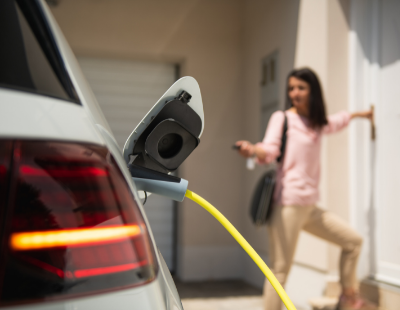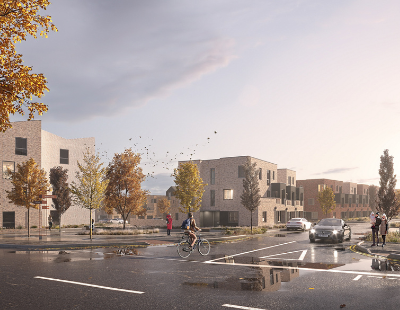In this guest article, Isabel James, head of residential at Connected Kerb, one of the UK’s leading on-street electric vehicle (EV) charging providers, discusses the challenges and opportunities for developers looking to navigate the EV transition.
With just eight years until the 2030 ban on the sale of new petrol and diesel cars, registrations of battery EVs were up 79% this March compared to a year ago and more battery EVs were sold in the UK in March than in the whole of 2019. This trend is incredibly significant and isn’t expected to slow down any time soon. It’s therefore crucial that EV charging infrastructure keeps pace.
Property developers are in a unique position to drive this change by installing EV chargers on mass in new homes, and policymakers are taking note. Late last year, the UK Government introduced legislation requiring all new builds to host EV charging – a significant challenge for residential and commercial developers.
While the new legislation is welcome news as a way to support the EV transition, it’s not without risks. Namely, installing new chargers could become a box-ticking exercise, with cheap, low-quality infrastructure installed en mass to meet the legislation in the short term. In the long run, this means poor quality chargers which break and need to be replaced more frequently, jeopardising consumer confidence in EVs and pushing up overall costs for residential developers and property owners.
By taking a responsible, long-term approach to EV charging, developers can do more than just support the EV transition, they can gain a crucial competitive advantage – a survey by Rightmove last year, found a six-fold increase in the number of homes being sold with EV charging as the equipment becomes more and more important to home buyers.
What does the new legislation mean for property developers?
Under the new legislation, all new homes and buildings in England will be required to install EV charging points. This includes new-build supermarkets, workplaces and buildings undergoing major renovations. The scale of this cannot be overstated – the government expects the move will see up to 145,000 charging points installed across the country each year. However, when it comes to EV charging, quality is just as important as quantity.
Getting EV charging right
Within the challenges bought about by the new legislation, there lies a rich vein of opportunity for developers to get it right on EV charging – something that not only makes good environmental sense, but good business sense too.
Our recent report ‘How to meet the UK’s electric vehicle charging need’ – containing original data and insights from experts across the industry – set out key recommendations to support residential and property developers to navigate EV charging, gaining a competitive edge and helping to enable a smooth transition to an electric future in the process.
Thinking ahead is a big time and money saver down the line, so installing key charging infrastructure ahead of demand will help keep costs low and improve reliability.
Installing behind-the-scenes infrastructure, such as putting the right electricity provisions in place in private car parks from the start, is a perfect example of this. Once the power is in place, it’s simply a case of installing more plugs above ground when demand grows. Continually replacing entire chargers to add more power and capacity is not only costly for developers responsible for ongoing management of developments, but the disruption it causes can be detrimental to the reputation of developers who will not manage the property over the long term – this is an important competitive edge against other developers tempted to “set and forget” lower quality charging infrastructure.
The same logic can be applied to the quality of the charger itself. In order to get the best value out of EV charging, developers must also avoid the mistake of installing EV charging as a simple box-ticking exercise, and instead opt for solutions that genuinely future-proof buildings for the new generations of EV drivers.
Choosing long term reliable infrastructure, as opposed to cheaper low-quality infrastructure means chargers will need to be replaced less frequently. Instead, developers should look to higher quality infrastructure that is built to last and make long-term operation and maintenance agreements with charging providers that last 20+ years, saving considerable costs in the long term and maintaining a positive image from consumers.
This is the approach Barratt Homes and Connected Kerb took in a recent 20-year development of 3,000 homes in Swindon. Working with Connected Kerb, the project deployed underground enabling infrastructure for over 130 EV charging points during ‘Phase 0 construction’. An initial 20 active charging sockets were deployed in shared and visitor parking bays. As demand from residents increases, new EV charging sockets can be installed in less than an hour.
The EV charging race is on
With the rapidly growing demand for charging coupled with tightening legislation, the race is now on for developers to find a reliable and long-term solution to the EV charging challenge. While some could perceive this as a just another box to tick, others will recognise the opportunity it presents. By adopting a long-term approach to the challenge, developers can ensure they get EV charging right, support the widespread transition to cleaner transport, and gain a competitive edge.
*Isabel James is the head of residential at Connected Kerb







.jpeg)
.png)

.jpg)








Join the conversation
Jump to latest comment and add your reply
Why oh why would we want electric vehicles?
People don’t seem to understand what is involved in the production of them and how unproductive they are. Firstly, they run on electricity and how do you produce electricity? Answer fossil fuel.
Then they use a battery, so how long are these batteries going to last and how reliable are they going to be? Answer they like all batteries are going to start detreating and failing so do less miles, then they are going to fail and need replacing and how much is that going to cost? What are they going to do with the old ones? How many people are going to scrap their cars early instead of replacing the batteries and what effect is that going to have? And so on.
Has anyone really sat down and thought this through?
So why not produce Hydrogen cars instead? Yes, there may be the initial setup of production and just like for electric car the points for re-fuelling, but once in place they would be much more reliable & cheaper to run and the effects on the environment would be amazing ‘Simple’.
Please login to comment